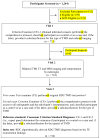The Research Diagnostic Criteria for Temporomandibular Disorders. I: overview and methodology for assessment of validity
- PMID: 20213028
- PMCID: PMC3157055
The Research Diagnostic Criteria for Temporomandibular Disorders. I: overview and methodology for assessment of validity
Abstract
Aims: The purpose of the Research Diagnostic Criteria for Temporomandibular Disorders (RDC/TMD) Validation Project was to assess the diagnostic validity of this examination protocol. The aim of this article is to provide an overview of the project's methodology, descriptive statistics, and data for the study participant sample. This article also details the development of reliable methods to establish the reference standards for assessing criterion validity of the Axis I RDC/TMD diagnoses.
Methods: The Axis I reference standards were based on the consensus of two criterion examiners independently performing a comprehensive history, clinical examination, and evaluation of imaging. Intersite reliability was assessed annually for criterion examiners and radiologists. Criterion examination reliability was also assessed within study sites.
Results: Study participant demographics were comparable to those of participants in previous studies using the RDC/TMD. Diagnostic agreement of the criterion examiners with each other and with the consensus-based reference standards was excellent with all kappas > or = 0.81, except for osteoarthrosis (moderate agreement, k = 0.53). Intrasite criterion examiner agreement with reference standards was excellent (k > or = 0.95). Intersite reliability of the radiologists for detecting computed tomography-disclosed osteoarthrosis and magnetic resonance imaging-disclosed disc displacement was good to excellent (k = 0.71 and 0.84, respectively).
Conclusion: The Validation Project study population was appropriate for assessing the reliability and validity of the RDC/TMD Axis I and II. The reference standards used to assess the validity of Axis I TMD were based on reliable and clinically credible methods.
Figures



References
-
- Dworkin SF, LeResche L. Research diagnostic criteria for temporomandibular disorders: Review criteria, examinations and specifications, critique. J of Craniomandib Dis. 1992;6:301–355. - PubMed
-
- Dworkin SF, von Korff MR, LeResche L. Epidemiologic studies of chronic pain: A dynamic-ecologic perspective. Ann Behav Med. 1992;14:3–11.
-
- Proceedings. Oral Surgery Oral Medicine Oral Pathology Oral Radiology & Endodontics; National Institutes of Health Technology Assessment Conference on Management of Temporomandibular Disorders; Bethesda, Maryland. April 29–May 1, 1996; 1992. pp. 49–183. - PubMed
-
- International RDC-TMD Consortium Network. 2007 http://rdc-tmdinternational.org.
-
- Dworkin SF, Sherman J, Mancl L, Ohrbach R, LeResche L, Truelove E. Reliability, validity, and clinical utility of the research diagnostic criteria for Temporomandibular Disorders Axis II Scales: depression, non-specific physical symptoms, and graded chronic pain. J Orofac Pain. 2002;16:207–220. - PubMed
Publication types
MeSH terms
Grants and funding
LinkOut - more resources
Full Text Sources
Medical
